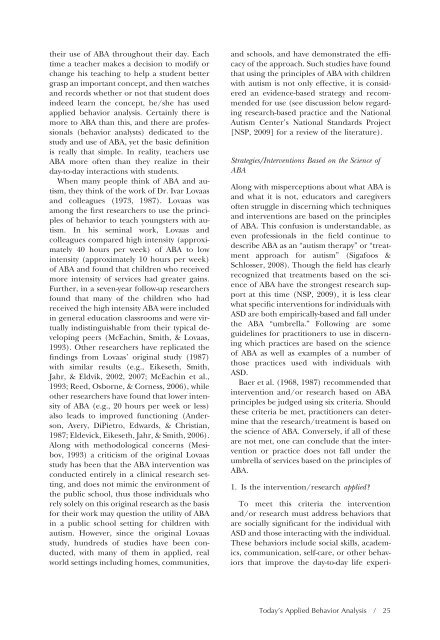Beyond Time Out and Table Time - Division on Autism and ...
Beyond Time Out and Table Time - Division on Autism and ...
Beyond Time Out and Table Time - Division on Autism and ...
You also want an ePaper? Increase the reach of your titles
YUMPU automatically turns print PDFs into web optimized ePapers that Google loves.
their use of ABA throughout their day. Each<br />
time a teacher makes a decisi<strong>on</strong> to modify or<br />
change his teaching to help a student better<br />
grasp an important c<strong>on</strong>cept, <str<strong>on</strong>g>and</str<strong>on</strong>g> then watches<br />
<str<strong>on</strong>g>and</str<strong>on</strong>g> records whether or not that student does<br />
indeed learn the c<strong>on</strong>cept, he/she has used<br />
applied behavior analysis. Certainly there is<br />
more to ABA than this, <str<strong>on</strong>g>and</str<strong>on</strong>g> there are professi<strong>on</strong>als<br />
(behavior analysts) dedicated to the<br />
study <str<strong>on</strong>g>and</str<strong>on</strong>g> use of ABA, yet the basic definiti<strong>on</strong><br />
is really that simple. In reality, teachers use<br />
ABA more often than they realize in their<br />
day-to-day interacti<strong>on</strong>s with students.<br />
When many people think of ABA <str<strong>on</strong>g>and</str<strong>on</strong>g> autism,<br />
they think of the work of Dr. Ivar Lovaas<br />
<str<strong>on</strong>g>and</str<strong>on</strong>g> colleagues (1973, 1987). Lovaas was<br />
am<strong>on</strong>g the first researchers to use the principles<br />
of behavior to teach youngsters with autism.<br />
In his seminal work, Lovaas <str<strong>on</strong>g>and</str<strong>on</strong>g><br />
colleagues compared high intensity (approximately<br />
40 hours per week) of ABA to low<br />
intensity (approximately 10 hours per week)<br />
of ABA <str<strong>on</strong>g>and</str<strong>on</strong>g> found that children who received<br />
more intensity of services had greater gains.<br />
Further, in a seven-year follow-up researchers<br />
found that many of the children who had<br />
received the high intensity ABA were included<br />
in general educati<strong>on</strong> classrooms <str<strong>on</strong>g>and</str<strong>on</strong>g> were virtually<br />
indistinguishable from their typical developing<br />
peers (McEachin, Smith, & Lovaas,<br />
1993). Other researchers have replicated the<br />
findings from Lovaas’ original study (1987)<br />
with similar results (e.g., Eikeseth, Smith,<br />
Jahr, & Eldvik, 2002, 2007; McEachin et al.,<br />
1993; Reed, Osborne, & Corness, 2006), while<br />
other researchers have found that lower intensity<br />
of ABA (e.g., 20 hours per week or less)<br />
also leads to improved functi<strong>on</strong>ing (Anders<strong>on</strong>,<br />
Avery, DiPietro, Edwards, & Christian,<br />
1987; Eldevick, Eikeseth, Jahr, & Smith, 2006).<br />
Al<strong>on</strong>g with methodological c<strong>on</strong>cerns (Mesibov,<br />
1993) a criticism of the original Lovaas<br />
study has been that the ABA interventi<strong>on</strong> was<br />
c<strong>on</strong>ducted entirely in a clinical research setting,<br />
<str<strong>on</strong>g>and</str<strong>on</strong>g> does not mimic the envir<strong>on</strong>ment of<br />
the public school, thus those individuals who<br />
rely solely <strong>on</strong> this original research as the basis<br />
for their work may questi<strong>on</strong> the utility of ABA<br />
in a public school setting for children with<br />
autism. However, since the original Lovaas<br />
study, hundreds of studies have been c<strong>on</strong>ducted,<br />
with many of them in applied, real<br />
world settings including homes, communities,<br />
<str<strong>on</strong>g>and</str<strong>on</strong>g> schools, <str<strong>on</strong>g>and</str<strong>on</strong>g> have dem<strong>on</strong>strated the efficacy<br />
of the approach. Such studies have found<br />
that using the principles of ABA with children<br />
with autism is not <strong>on</strong>ly effective, it is c<strong>on</strong>sidered<br />
an evidence-based strategy <str<strong>on</strong>g>and</str<strong>on</strong>g> recommended<br />
for use (see discussi<strong>on</strong> below regarding<br />
research-based practice <str<strong>on</strong>g>and</str<strong>on</strong>g> the Nati<strong>on</strong>al<br />
<strong>Autism</strong> Center’s Nati<strong>on</strong>al St<str<strong>on</strong>g>and</str<strong>on</strong>g>ards Project<br />
[NSP, 2009] for a review of the literature).<br />
Strategies/Interventi<strong>on</strong>s Based <strong>on</strong> the Science of<br />
ABA<br />
Al<strong>on</strong>g with mispercepti<strong>on</strong>s about what ABA is<br />
<str<strong>on</strong>g>and</str<strong>on</strong>g> what it is not, educators <str<strong>on</strong>g>and</str<strong>on</strong>g> caregivers<br />
often struggle in discerning which techniques<br />
<str<strong>on</strong>g>and</str<strong>on</strong>g> interventi<strong>on</strong>s are based <strong>on</strong> the principles<br />
of ABA. This c<strong>on</strong>fusi<strong>on</strong> is underst<str<strong>on</strong>g>and</str<strong>on</strong>g>able, as<br />
even professi<strong>on</strong>als in the field c<strong>on</strong>tinue to<br />
describe ABA as an “autism therapy” or “treatment<br />
approach for autism” (Sigafoos &<br />
Schlosser, 2008). Though the field has clearly<br />
recognized that treatments based <strong>on</strong> the science<br />
of ABA have the str<strong>on</strong>gest research support<br />
at this time (NSP, 2009), it is less clear<br />
what specific interventi<strong>on</strong>s for individuals with<br />
ASD are both empirically-based <str<strong>on</strong>g>and</str<strong>on</strong>g> fall under<br />
the ABA “umbrella.” Following are some<br />
guidelines for practiti<strong>on</strong>ers to use in discerning<br />
which practices are based <strong>on</strong> the science<br />
of ABA as well as examples of a number of<br />
those practices used with individuals with<br />
ASD.<br />
Baer et al. (1968, 1987) recommended that<br />
interventi<strong>on</strong> <str<strong>on</strong>g>and</str<strong>on</strong>g>/or research based <strong>on</strong> ABA<br />
principles be judged using six criteria. Should<br />
these criteria be met, practiti<strong>on</strong>ers can determine<br />
that the research/treatment is based <strong>on</strong><br />
the science of ABA. C<strong>on</strong>versely, if all of these<br />
are not met, <strong>on</strong>e can c<strong>on</strong>clude that the interventi<strong>on</strong><br />
or practice does not fall under the<br />
umbrella of services based <strong>on</strong> the principles of<br />
ABA.<br />
1. Is the interventi<strong>on</strong>/research applied?<br />
To meet this criteria the interventi<strong>on</strong><br />
<str<strong>on</strong>g>and</str<strong>on</strong>g>/or research must address behaviors that<br />
are socially significant for the individual with<br />
ASD <str<strong>on</strong>g>and</str<strong>on</strong>g> those interacting with the individual.<br />
These behaviors include social skills, academics,<br />
communicati<strong>on</strong>, self-care, or other behaviors<br />
that improve the day-to-day life experi-<br />
Today’s Applied Behavior Analysis / 25
















